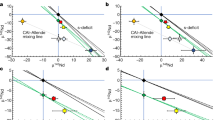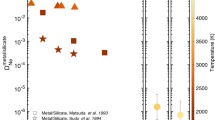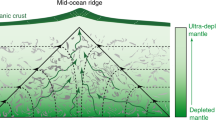Abstract
Information about the materials and conditions involved in planetary formation and differentiation in the early Solar System is recorded in iron isotope ratios. Samples from Earth, the Moon, Mars and the asteroid Vesta reveal significant variations in iron isotope ratios, but the sources of these variations remain uncertain. Here we present experiments that demonstrate that under the conditions of planetary core formation expected for the Moon, Mars and Vesta, iron isotopes fractionate between metal and silicate due to the presence of nickel, and enrich the bodies’ mantles in isotopically light iron. However, the effect of nickel diminishes at higher temperatures: under conditions expected for Earth’s core formation, we infer little fractionation of iron isotopes. From our experimental results and existing conceptual models of magma ocean crystallization and mantle partial melting, we find that nickel-induced fractionation can explain iron isotope variability found in planetary samples without invoking nebular or accretionary processes. We suggest that near-chondritic iron isotope ratios of basalts from Mars and Vesta, as well as the most primitive lunar basalts, were achieved by melting of isotopically light mantles, whereas the heavy iron isotope ratios of terrestrial ocean floor basalts are the result of melting of near-chondritic Earth mantle.
This is a preview of subscription content, access via your institution
Access options
Access Nature and 54 other Nature Portfolio journals
Get Nature+, our best-value online-access subscription
$29.99 / 30 days
cancel any time
Subscribe to this journal
Receive 12 print issues and online access
$259.00 per year
only $21.58 per issue
Buy this article
- Purchase on Springer Link
- Instant access to full article PDF
Prices may be subject to local taxes which are calculated during checkout



Similar content being viewed by others
References
Young, E. D. et al. Oxygen isotopic evidence for vigorous mixing during the Moon-forming giant impact. Science 351, 493–496 (2016).
Zhang, J. J., Dauphas, N., Davis, A. M., Leya, I. & Fedkin, A. The proto-Earth as a significant source of lunar material. Nat. Geosci. 5, 251–255 (2012).
Lugmair, G. W. & Shukolyukov, A. Early Solar System timescales according to 53Mn-53Cr systematics. Geochim. Cosmochim. Acta 62, 2863–2886 (1998).
Poitrasson, F., Halliday, A. N., Lee, D. C., Levasseur, S. & Teutsch, N. Iron isotope differences between Earth, Moon, Mars and Vesta as possible records of contrasted accretion mechanisms. Earth Planet. Sci. Lett. 223, 253–266 (2004).
Weyer, S. et al. Iron isotope fractionation during planetary differentiation. Earth Planet. Sci. Lett. 240, 251–264 (2005).
Schoenberg, R. & von Blanckenburg, F. Modes of planetary-scale Fe isotope fractionation. Earth Planet. Sci. Lett. 252, 342–359 (2006).
Teng, F. Z., Dauphas, N., Huang, S. C. & Marty, B. Iron isotopic systematics of oceanic basalts. Geochim. Cosmochim. Acta 107, 12–26 (2013).
Craddock, P. R., Warren, J. M. & Dauphas, N. Abyssal peridotites reveal the near-chondritic Fe isotopic composition of the Earth. Earth Planet. Sci. Lett. 365, 63–76 (2013).
Wang, K. et al. Iron isotope fractionation in planetary crusts. Geochim. Cosmochim. Acta 89, 31–45 (2012).
Liu, Y. et al. Oxygen and iron isotope constraints on near-surface fractionation effects and the composition of lunar mare basalt source regions. Geochim. Cosmochim. Acta 74, 6249–6262 (2010).
Craddock, P. R. & Dauphas, N. Iron isotopic compositions of geological reference materials and chondrites. Geostand. Geoanal. Res. 35, 101–123 (2011).
Williams, H. M. et al. Fe isotope fractionation in iron meteorites: new insights into metal-sulphide segregation and planetary accretion. Earth Planet. Sci. Lett. 250, 486–500 (2006).
Poitrasson, F., Levasseur, S. & Teutsch, N. Significance of iron isotope mineral fractionation in pallasites and iron meteorites for the core-mantle differentiation of terrestrial planets. Earth Planet. Sci. Lett. 234, 151–164 (2005).
Sossi, P. A., Nebel, O., Anand, M. & Poitrasson, F. On the iron isotope composition of Mars and volatile depletion in the terrestrial planets. Earth Planet. Sci. Lett. 449, 360–371 (2016).
Scott, E. R. D. Chemical fractionation in iron meteorites and its interpretation. Geochim. Cosmochim. Acta 36, 1205–1236 (1972).
Poitrasson, F. Does planetary differentiation really fractionate iron isotopes? Earth Planet. Sci. Lett. 256, 484–492 (2007).
Williams, H. M., Wood, B. J., Wade, J., Frost, D. J. & Tuff, J. Isotopic evidence for internal oxidation of the Earth’s mantle during accretion. Earth Planet. Sci. Lett. 321, 54–63 (2012).
Polyakov, V. B. Equilibrium iron isotope fractionation at core–mantle boundary conditions. Science 323, 912–914 (2009).
Georg, R. B., Halliday, A. N., Schauble, E. A. & Reynolds, B. C. Silicon in the Earth’s core. Nature 447, 1102–1106 (2007).
Poitrasson, F., Roskosz, M. & Corgne, A. No iron isotope fractionation between molten alloys and silicate melt to 2000 degrees C and 7.7 GPa: experimental evidence and implications for planetary differentiation and accretion. Earth Planet. Sci. Lett. 278, 376–385 (2009).
Hin, R. C., Schmidt, M. W. & Bourdon, B. Experimental evidence for the absence of iron isotope fractionation between metal and silicate liquids at 1 GPa and 1250–1300 °C and its cosmochemical consequences. Geochim. Cosmochim. Acta 93, 164–181 (2012).
Shahar, A. et al. Sulfur-controlled iron isotope fractionation experiments of core formation in planetary bodies. Geochim. Cosmochim. Acta 150, 253–264 (2015).
Badro, J., Cote, A. S. & Brodholt, J. P. A seismologically consistent compositional model of Earth’s core. Proc. Natl Acad. Sci. USA 111, 7542–7545 (2014).
Shahar, A., Elardo, S. M. & Macris, C. A. in Non-Traditional Stable Isotopes Vol. 82 (eds Teng, F. Z., Dauphas, N. & Watkins, J. M.) Ch. 3, 65–84 (Reviews in Mineralogy and Geochemistry, Mineralogical Society of America, 2017).
Hume-Rothery, W. The Structures of Alloys of Iron: An Elementary Introduction (Elsevier, 2013).
Li, J. & Agee, C. B. The effect of pressure, temperature, oxygen fugacity and composition on partitioning of nickel and cobalt between liquid Fe-Ni-S alloy and liquid silicate: implications for the Earth’s core formation. Geochim. Cosmochim. Acta 65, 1821–1832 (2001).
McDonough, W. F. & Sun, S. S. The composition of the Earth. Chem. Geol. 120, 223–253 (1995).
Righter, K. & Drake, M. J. Core formation in Earth’s Moon, Mars, and Vesta. Icarus 124, 513–529 (1996).
Dreibus, G. & Wänke, H. Mars, a volatile-rich planet. Hans Suess Festschrift 20, 367–381 (1985).
O’Neill, H. S. C. The origin of the Moon and the early history of the Earth - a chemical model. Part 1: the Moon. Geochim. Cosmochim. Acta 55, 1135–1157 (1991).
Hertogen, J., Vizgirda, J. & Anders, E. Composition of the parent body of eucritic meteorites. Bull. Am. Astronom. Soc. 9, 458 (1977).
Anderson, D. L. Internal constitution of Mars. J. Geophys. Res. 77, 789–795 (1972).
Corgne, A., Siebert, J. & Badro, J. Oxygen as a light element: a solution to single-stage core formation. Earth Planet. Sci. Lett. 288, 108–114 (2009).
Siebert, J., Badro, J., Antonangeli, D. & Ryerson, F. J. Terrestrial accretion under oxidizing conditions. Science 339, 1194–1197 (2013).
O’Rourke, J. G. & Stevenson, D. J. Powering Earth’s dynamo with magnesium precipitation from the core. Nature 529, 387–389 (2016).
Steenstra, E. S., Rai, N., Knibbe, J. S., Lin, Y. H. & van Westrenen, W. New geochemical models of core formation in the Moon from metal-silicate partitioning of 15 siderophile elements. Earth Planet. Sci. Lett. 441, 1–9 (2016).
Pringle, E. A., Savage, P. S., Badro, J., Barrat, J. A. & Moynier, F. Redox state during core formation on asteroid 4-Vesta. Earth Planet. Sci. Lett. 373, 75–82 (2013).
Righter, K. & Chabot, N. L. Moderately and slightly siderophile element constraints on the depth and extent of melting in early Mars. Meteorit. Planet. Sci. 46, 157–176 (2011).
Steenstra, E. S., Knibbe, J. S., Rai, N. & van Westrenen, W. Constraints on core formation in Vesta from metal-silicate partitioning of siderophile elements. Geochim. Cosmochim. Acta 177, 48–61 (2016).
Russell, C. T. et al. Dawn at Vesta: testing the protoplanetary paradigm. Science 336, 684–686 (2012).
Shahar, A. et al. Pressure-dependent isotopic composition of iron alloys. Science 352, 580–582 (2016).
Dauphas, N. et al. Magma redox and structural controls on iron isotope variations in Earth’s mantle and crust. Earth Planet. Sci. Lett. 398, 127–140 (2014).
Teng, F. Z., Dauphas, N. & Helz, R. T. Iron isotope fractionation during magmatic differentiation in Kilauea Iki Lava Lake. Science 320, 1620–1622 (2008).
Weyer, S. What drives iron isotope fractionation in magma? Science 320, 1600–1601 (2008).
Sossi, P. A., Foden, J. D. & Halverson, G. P. Redox-controlled iron isotope fractionation during magmatic differentiation: an example from the Red Hill intrusion, S. Tasmania. Contrib. Mineral. Petrol. 164, 757–772 (2012).
Snyder, G. A., Taylor, L. A. & Neal, C. R. A chemical model for generating the sources of mare basalts: combined equilibrium and fractional crystallization of the lunar magmasphere. Geochim. Cosmochim. Acta 56, 3809–3823 (1992).
Hess, P. C. & Parmentier, E. M. A model for the thermal and chemical evolution of the Moon’s interior: implications for the onset of mare volcanism. Earth Planet. Sci. Lett. 134, 501–514 (1995).
Elardo, S. M., Draper, D. S. & Shearer, C. K. Lunar magma ocean crystallization revisited: bulk composition, early cumulate mineralogy, and the source regions of the highlands Mg-suite. Geochim. Cosmochim. Acta 75, 3024–3045 (2011).
Shearer, C. K. & Papike, J. J. Basaltic magmatism on the Moon: a perspective from volcanic picritic glass beads. Geochim. Cosmochim. Acta 57, 4785–4812 (1993).
Hess, P. C. On the source regions for mare picrite glasses. J. Geophys. Res. 105, 4347–4360 (2000).
Vander Kaaden, K. E., Agee, C. B. & McCubbin, F. M. Density and compressibility of the molten lunar picritic glasses: implications for the roles of Ti and Fe in the structures of silicate melts. Geochim. Cosmochim. Acta 149, 1–20 (2015).
Elardo, S. M., Shearer, C. K., Kaaden, K. E. V., McCubbin, F. M. & Bell, A. S. Petrogenesis of primitive and evolved basalts in a cooling Moon: experimental constraints from the youngest known lunar magmas. Earth Planet. Sci. Lett. 422, 126–137 (2015).
Ritchie, N. W. M., Newbury, D. E. & Davis, J. M. EDS measurements of X-ray intensity at WDS precision and accuracy using a silicon drift detector. Microsc. Microanal. 18, 892–904 (2012).
Armstrong, J. T. Comparative performance of SDD-EDS and WDS detectors for quantitative analysis of mineral specimens: the next generation of electron microprobe. Microsc. Microanal. 20, 692–693 (2014).
Dauphas, N., Pourmand, A. & Teng, F. Z. Routine isotopic analysis of iron by HR-MC-ICPMS: how precise and how accurate? Chem. Geol. 267, 175–184 (2009).
Shahar, A., Young, E. D. & Manning, C. E. Equilibrium high-temperature Fe isotope fractionation between fayalite and magnetite: an experimental calibration. Earth Planet. Sci. Lett. 268, 330–338 (2008).
Acknowledgements
We are grateful to T. D. Mock, M. F. Horan, C. K. I. Sio and J. A. Armstrong for assistance with clean laboratory chemistry, mass spectrometry and SDD–EDS analyses. J. Labidi is thanked for providing comments on an early version of the manuscript. This work was funded by NSF grant EAR-1321858 to A.S.
Author information
Authors and Affiliations
Contributions
Both authors contributed equally to this work.
Corresponding author
Ethics declarations
Competing interests
The authors declare no competing financial interests.
Supplementary information
Supplementary Information
Supplementary Information (PDF 2206 kb)
Rights and permissions
About this article
Cite this article
Elardo, S., Shahar, A. Non-chondritic iron isotope ratios in planetary mantles as a result of core formation. Nature Geosci 10, 317–321 (2017). https://doi.org/10.1038/ngeo2896
Received:
Accepted:
Published:
Issue Date:
DOI: https://doi.org/10.1038/ngeo2896
This article is cited by
-
Early planetary processes and light elements in iron-dominated cores
Acta Geochimica (2022)
-
Isotopic evolution of planetary crusts by hypervelocity impacts evidenced by Fe in microtektites
Nature Communications (2021)
-
Correlated iron isotopes and silicon contents in aubrite metals reveal structure of their asteroidal parent body
Scientific Reports (2021)
-
Si-Mg isotopes in enstatite chondrites and accretion of reduced planetary bodies
Scientific Reports (2020)
-
Iron isotope fractionation at the core–mantle boundary by thermodiffusion
Nature Geoscience (2020)



